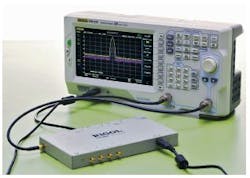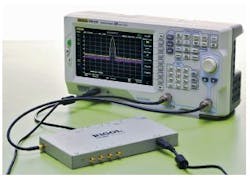Spectrum analysis is a necessary function in many test laboratories, but one that usually comes with a premium price tag. The DSA815 spectrum analyzer from Rigol Technologies (www.rigolna.com) represents a cost-effective alternative for engineers in need of this measurement capability but with limited funds. This full-featured instrument incorporates an all-digital intermediate-frequency (IF) section for accurate, high-resolution measurements from 9 kHz to 1.5 GHz
A spectrum analyzer provides a display of signal amplitude versus frequency, allowing an operator to select from a series of IF filters to reduce the displayed bandwidth and isolate a signal of interest from the noise floor. By designing the DSA815 spectrum analyzer (see figure) with a digital IF section, the variations in amplitude over time and frequency associated with analog filtering can be minimized. With the stable filters afforded by digital signal processing, the DSA815’s digital IF section allows an operator to use an IF filter just wide enough to pass a signal of interest. In the process, it limits the amount of noise received by the analyzer’s receiver and shown on the display, thus lowering the instrument’s displayed average noise level (DANL).
The DSA815 spectrum analyzer includes an all-digital IF section for accurate measurements from 9 kHz to 1.5 GHz.
The use of a digital IF helps minimize errors due to filter switching and reference level uncertainties; it can even limit errors produced when switching between logarithmic and linear displays of amplitude, which occur when using a spectrum analyzer with a traditional analog IF section.
The DSA815 provides 3-dB resolution-bandwidth (RBW) filters that can be set from 100 Hz to 1 MHz in a 1-3-10 sequence with nominal RBW uncertainty of less than 5%. It also offers video-bandwidth (VBW) filters from 1 Hz to 3 MHz in a 1-3-10 sequence. Operators can set frequency spans from 100 Hz wide to the full bandwidth (1.5 GHz) of the instrument.
The DSA815 derives its frequency stability and accuracy from an internal 10-MHz reference oscillator with aging rate of better than 2 ppm/yr and temperature stability of better than 2 ppm from +20 to +30°C. It can also work with an external 10-MHz reference source (via a BNC input connector) at a level of 0 to +10 dBm. The DSA815 exhibits phase noise of typically −80 dBc/Hz offset 10 kHz from any carrier.
In terms of its amplitude capabilities, the DSA815 can handle input levels as high as +20 dBm and to typically +30 dBm. Without the preamplifier, the DANL is typically −110 dBm from 100 kHz to 1 MHz and −115 dBm from 1 MHz to 1.5 GHz. With it, the DANL is typically −130 dBm from 100 kHz to 1 MHz and −135 dBm from 1 MHz to 1.5 GHz.
The reference level is adjustable from −100 to +20 dBm in 1-dB steps with 0.01-dB resolution and four digits resolution in the linear scale. The analyzer’s frequency response is within 0.7 dB window from 100 kHz to 1.5 GHz with preamplifier off and within a 1-dB window from 1 MHz to 1.5 GHz with it on.
The DSA815 measures 14.2 x 7.0 x 5.0 in. The unit shows captured signals on an 8-in. diagonal thin-film-transistor (TFT) liquid-crystal-display (LCD) screen with 800 x 480 pixel resolution. Input signals are fed to the analyzer via a 50-Ω Type N female connector.
The spectrum analyzer provides connectivity by means of an Ethernet local-area-network (LAN) connector or Universal-Serial-Bus (USB) connection to a personal computer, with GPIB connectivity available as an option. The optional model DSA815-TG tracking generator provides −20 to 0 dBm output power with ±3 dB output flatness from 1 MHz to 1.5 GHz for performing VSWR testing or scalar analysis. P&A: $1295 and up; stock.
Rigol Technologies, 7401 First Pl., Ste. N., Oakwood Village, OH 44146; (440) 232-4488, e-mail: [email protected], www.rigolna.com.
About the Author
Jack Browne
Technical Contributor
Jack Browne, Technical Contributor, has worked in technical publishing for over 30 years. He managed the content and production of three technical journals while at the American Institute of Physics, including Medical Physics and the Journal of Vacuum Science & Technology. He has been a Publisher and Editor for Penton Media, started the firm’s Wireless Symposium & Exhibition trade show in 1993, and currently serves as Technical Contributor for that company's Microwaves & RF magazine. Browne, who holds a BS in Mathematics from City College of New York and BA degrees in English and Philosophy from Fordham University, is a member of the IEEE.

